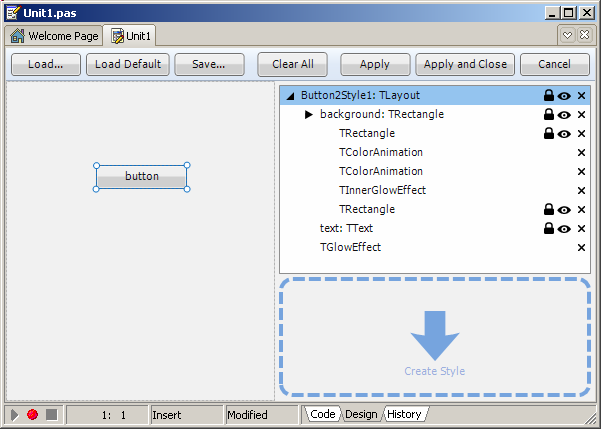Are there special steps for styling a button using stylebook in FMX? Because whenever I change my style it works in the viewer only, however when I run the program nothing changes although stylebook setting are properly connected to style files and to the application as well, also if I close the program and start it again I find the same style saved and exists in the view but when run the application I cant find any style, can anyone tell me the exact steps? Because I check tutorials, docs, help but still stylebook wont apply the new changes to the app at run time. To modify the default style: • Start with a blank fmx form and add a TButton. • Right-Click on the button and select Edit Default Style. - the Style Designer opens • In the Structure pane select Buttonstyle - text • In the Object Inspector change the NormalColor property to Crimson. The text of the button changes to Crimson (red) color.

• Hit the designer view Close button (X) and confirm to Apply changes. By clicling Yes when prompted. Note that a Stylebook has been added to the form. • Build and run The result looks like this on Windows 7 Maybe you have omitted step 5 (just guessing) With an existing stylebook and style do as follows: • Start with a blank fmx form and add a TButton. • Add a TStyleBook, set its UseStyleManager property, double-click it and load an existing style (e.g. Air) • In the structure pane select buttonstyle - text. Note that available properties are not necessarily the same as when editing the default style.
• In the Object Inspector change the Font - FontColor property to Yellow. The text of the button changes to yellow color. • Hit the designer view Close button (X) and confirm to Apply changes. By clicling Yes when prompted.
VCloud Suite 7.0 is also released and available to download (here) This. Be time to upgrade my capacity disks from HDD's to SSD's and get cracking.. In an enterprise datacenter, All Flash VSAN can drastically improve your. Vmware vcenter log insight keygen crack software.
• Build and run The result looks like this on Windows 7.
ID: 30491, FireMonkey Premium Styles Pack for RAD Studio 10.1 and 10.2. Choose from Jet, Sterling, Diamond, Emerald Crystal, Emerald Dark, Coral Crystal, Coral Dark, Vapor, Copper, Copper Dark and Radiant styles, optimized for iOS, Android, Windows and Mac application development. Available to registered users of RAD Studio.
Go Up to FireMonkey controls are arrangements of a tree composed of subcontrols, primitive shapes and brushes, decorated with effects. These compositions are defined as styles, stored in a style book. The individual elements of a style are internally called resources; because that term has several other meanings, the term style-resource is used for clarity. Styles provide a great deal of customization without subclassing. On a 32-bit Windows development system, the FireMonkey styles that are provided with the product are located in: C: Program Files Embarcadero Appmethod n.n Redist styles Fmx On a 64-bit Windows development system, the FireMonkey styles are located in: C: Program Files (x86) Embarcadero Appmethod n.n Redist styles Fmx. Contents • • • • • • • • Default Styles In FireMonkey, each control class has a default style, hard-coded per platform. To see the style definitions in the: • For a FireMonkey desktop application: • Drop a control on a form in the Form Designer.
• Right-click the control and choose Edit Default Style. • For a FireMonkey mobile app: • Drop a on the form in the Form Designer. • Double-click the stylebook. This creates a copy of the internal hard-coded style. For example, the default style of is defined simply as: • panelstyle: TRectangle The name of the style-resource that defines the style is 'panelstyle'. Cs 1 6 anti ban hack warzone pc.
It refers to a. The appearance of this rectangle can be changed in the Style Designer, and then every TPanel on the form will have that appearanace by default. But there is no rule that a TPanel must be represented by a TRectangle. A or would work. Even simple controls can be a complex composition. Object TBrushObject StyleName = 'somebrush' end Nested Styles Styles may refer to other styled components. As always, styles are found by their top-level names in the TStyleBook.
For example, to use the same gradient: • In the FireMonkey Style Designer, save the existing styles in a.style file. • Edit the file with a text editor to create a TBrushObject. Use an appropriate StyleName.
• Load the.style file. • Select the newly defined style so that it appears in the Object Inspector. • Open the Brush property: • Edit the Gradient property with the (choose Edit from the property value's drop-down menu) • Set the Kind property to bkGradient • For each component using the gradient, for example, with a TRectangle's Fill property: • Set the Kind property to bkResource • Open the Resource property (a TBrushResource) and set the StyleLookup to the name of the gradient in Step 2.